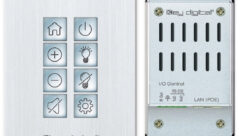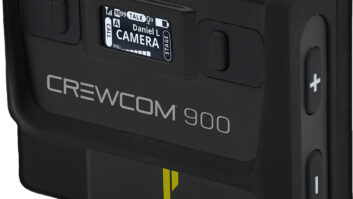Under lock and key
Sep 1, 1999 12:00 PM,
Ted Uzzle
A primer on controlling noise, determining rumble and hiss, and predictingnoise transmission.
This article covers the measurement of noise and its Evaluation. We willsee how to determine how much noise, and what type of noise, is too much.We will determine the subjective quality of noise (rumble or hiss). Then,we will turn to the study of walls, doors and windows and see how theyisolate critical rooms from surrounding noise. We will also practice theprediction of noise transmission and determine, in a hypothetical case, ifa proposed partition might serve its purpose.
This presentation can hardly make the novice an expert. Balancing anair-conditioning system to reduce its noise is only for the experienced;acoustical consultants are paid handsomely for this, and they deserve everypenny. In the same way, looking at a wall and knowing its internalconstruction, or being able to measure its transmission loss in situ,requires considerable architectural knowledge.
It is also true, however, that the communications systems designer andinstaller will see the effectiveness of his audio systems degraded ifintruding noise is too loud. This might happen because the noise-producingapparatus is located inappropriately or is in ill repair, or becauseinadequate partitions were built between the source and the critical room.
Installers and designers must know how to recognize a noise problem, mustknow how to measure it, and must know when to secure the services of acertified noise-control expert.
Some basics of measurement
We measure sound in three dimensions – pressure, frequency and duration.Sound pressure is measured in pascals (Pa). One pascal is one newton offorce into a cross-sectional area of one meter, one kilogram permeter-second-squared. The median threshold of audiologically normal humanhearing is 20 muPa. Sound-pressure level is decibelized sound pressurecompared to the median threshold:
20 log (variable pressure / 20 muPa)
The audio-frequency fluctuations of sound pressure we call sound are alwaysmeasured as root-mean-square (rms) averages. Ordinary, face-to-face humanspeech has a pressure of around 14 mPa, or about 57 dB SPL. One pascalcorresponds to a level of 94 dB SPL, about the same as a trained voice(Luciano Pavarotti) could shout directly into your face. One atmosphericpressure at sea level is about 101.3 kPa, or about 194 dB SPL.
Notice that sound-pressure level is not the same thing as loudness orloudness level. Loudness is a subjective perception, predicted by cognitivepsychology. The unit of loudness is the sone, and the unit of loudnesslevel is the phon.
Frequency is measured in hertz (Hz). One hertz is one event per second. Innoise-control work, we ordinarily organize frequency into octaves,doublings of frequency, whose characteristics are defined by internationalstandards. Notice that frequency is not the same thing as pitch. Pitch is asubjective perception, measured in mels.
Duration, of course, is measured in time units. In noise control, weusually employ seconds to measure duration, although hours, day-nightcycles, and days are also used in community-noise work.
Sound levels are measured with a sound-level meter. (See Figure 1.) Asound-level meter consists of several parts, including a calibrated mic andassociated preamp. An important accessory is a calibrator, which is used toconfirm measurement accuracy in the field. The calibrator consists of a cupthat fits over the mic and contains within itself a noise generator, an ampand a small loudspeaker. The mic may be integral to the meter, or it may beusable remotely through a cord.
The meter has a range switch so that the user may enjoy greater resolutionin reading the instrument. The meter will usually include a set of filters.These may simply be A and flat filters, or may include the older B and Cweightings, or octaves, or one-third octaves. (See Figure 2.) A-weightingrepresents a measurement in the frequency areas in which human hearing ismost acute, and it is often used in noise-control measurement. The readingsobtained this way are to be indicated dBA.
The meter will almost always include a time-integrating detector, shown asDT in Figure 1. This detector may simply let you choose fast or slow or mayinclude much more elaborate L subscript 90, L subscript 50 and L subscript10 settings. The meter will also have a display, which might be an analogneedle movement (in less costly meters), a digital readout or a graphicaldisplay (as in the case of real time analyzers).
When you measure noise, you must take two precautions about placing andholding the mic. (See Figure 3.) First, make sure the precise spot youplace the measurement mic is characteristic of more than merely that spot.Hold the meter as far away from you as you can and turn around 360 degreeswhile watching the display. Nowhere on the circumference of this circleshould the sound measurement change more than a couple of dB. This assuresyou that the position in the center of the circle is characteristic of alarger area than merely the mic diaphragm.
Second, if you suspect the noise or other sound being measured has aparticular directional characteristic, never, never stand facing the sourceholding the mic before you, pointing it to the source. If you do this,sound reflection from your body will affect the readings. Always turnsideways to the source and hold the mic away from you, the mic pointing at90 degrees to the source.
The acoustics of speech
Now let’s consider the characteristics of a sound source we are allintimately familiar with – human speech. Communications systems, whetherfor information or entertainment, always include speech as the single mostimportant element. Figure 4 shows male speech output level, in dB-SPL at adistance of one meter, as a function of frequency, and as a function ofsubjective vocal effort, from whisper to shout. Notice that differentcomponents of speech increase in different amounts. Speech includes acarrier wave, produced by the vocal cords; for male talkers, this carriervaries around 200 Hz to 350 Hz, slightly higher for female talkers. Thecarrier wave is amplitude-modulated by the tongue, the palate and the lips,and this modulation takes place around 1 kHz to 2.5 kHz. In the case of theshout, the mouth modulations are exaggerated, producing greater increasesin that range. In a whisper, the action of the vocal cords is reduced. Theactivity of the mouth, however, is reduce!d even more significantly.
Figure 5 shows the vocal effort required at different distances and againstdifferent noise levels. It is embodied in an American national standard,ANSI S3.14-1977. You start by measuring the noise levels in the 500 Hz, 1kHz, 2 kHz and 4 kHz octave bands and averaging them. That is called thespeech interference level (SIL). Finding the average in the horizontalaxis, move up to the distance (shown here in meters) between the talker andthe listener. If you are in the part of the graph that says normal voice,then speech communication is possible in the ordinary way. If you are inthe part that says raised, very loud or shout, those vocal efforts will berequired. Much beyond shout, unamplified voice communications will not bepossible.
There is also an area called normal in presence of noise. We instinctivelyand involuntarily raise our voices in the presence of noise. In this areaof the graph, talkers will raise their voices in that way, but stillconsider their voices in the normal range.
Here is an example. What if the noise average is 57 dB, and thetalker-to-listener distance is 3.5 m (11.5 feet)? Start at 56 dB on thehorizontal axis, and go up to 3.5 m. The talker must raise his voice. Whatif the noise average is 73 dB, and the distance is 1.3 m (4.3 feet)? Thespeaker must then speak very loudly or even shout. At 45 dB and 5 m (16.5feet), the speaker can probably use his normal voice.
Judging noise against criteria
Over the years, many noise criteria have been used by acousticians, manyways to figure noise acceptability in rooms for different purposes. We aregoing to study the balanced noise-criterion system published by Leo Beranekin 1989. It incorporates earlier research into the human response to noise,and it corresponds exceptionally well to today’s indoor noise,commercially, residentially and in places of public assembly. Itcorresponds most particularly to heating, ventilating and air-conditioning(HVAC) noise. In the perfectly designed room, the irreducible, unavoidablenoise floor comes from the HVAC system.
This strange-looking graph (Figure 6) is actually graph paper that is usedfor calculating balanced noise-criterion (NCB) numbers. The horizontal axisshows the octave bands in which you must measure the ambient noise levels,using the slow detection setting on your meter. Mark each band’smeasurement using the tick marks identified in the vertical axis. Connectthe measurements with a line, and observe the NCB-curve your line comesclosest to at its highest point. You may have to interpolate and arrive atsomething like NCB-48 or NCB-32. This is the balanced-noise number, theNCB-number, for the room.
The noise you measure will probably not follow the NCB curve precisely. Ifit did, the noise would be considered tonally neutral by those in the room,not rumbly or hissy. If your measurements above about 1 kHz were mostly 3dB below the NCB curve you have determined, listeners would consider thenoise a rumble. If your measurements below about 1 kHz were mostly 3 dBbelow the NCB curve you have determined, listeners would consider the noisea hiss.
There is a box at the upper left of Figure 6, divided into an upper partand a lower part. All noises in the upper part will primarily be perceivedas vibrations rather than sound. Room surfaces and furnishings may wellrattle audibly. In the lower part of the box, noises will be sensed asmoderate vibrations, depending on the vibration sensitivity of theindividual listener. S&VC grants permission for you to photocopy Figure 6for use in your next project.
What are the desired maximum balanced-noise numbers for variousapplications? Table 1 shows NCB numbers recommended as maxima for thedifferent occupancies of the room. Where a range of numbers is given,authorities disagree slightly. Notice that any place where there must be norisk of permanent hearing damage, the noise must not exceed NCB-70.
Let us check an example. In a cinema, we measure the following noiselevels: 31 Hz: 56 dB, 63 Hz: 51 dB, 125 Hz: 47 dB, 250 Hz: 46 dB, 500 Hz:44 dB, 1 kHz: 42 dB, 2 kHz: 37 dB, 4 kHz: 32 dB and 8 kHz: 23 dB. The noisemeasurements are charted in the graph. This is NCB-40, fairly well balancedbetween rumble and hiss. If this is a cinema, need we see the HVACspecialist?
Time-variant noise
Everything covered so far measures and describes noise that remainscomparatively constant. We want to use the slow detection on the meter, andso integrate our readings over about a second or a bit less. What aboutnoise that changes with time, from minute to minute or hour to hour as withtraffic noise, which increases appreciably when a truck or a motorcyclegoes by.
In Figure 8, we see traffic noise, which might be traffic noise takingplace over an hour. The noise level changes from below 60 dB-SPL to over 90dB-SPL. How can we attach a descriptive number to this noise? We find thatnoise level that is exceeded 90% of the time. This is a good measure of thelow boundary and is called L subscript 90. We also find that noise levelthat is exceeded 10% of the time. This is a good measure of the upperboundary and is called L subscript 10. In the example shown here:
L subscript 90 = 62 dB-SPL and
L subscript 10 = 88 dB-SPL.
The physics of noise isolation
Sound travels away from its source at approximately 1,130 ft/s (334 m/s).At a sufficient distance from its source, it forms a spherical wavefront.As the spherical wavefront expands, the pressure changes:
20 log (distance subscript 2 / distance subscript 1)
This predicts a change of -6 dB per doubling of distance. If there is abarrier in the path of the sound, the sound will be reflected in part,absorbed (converted to heat) in part, transmitted in part and possiblydiffracted in part. Some of the sound continues past the barrier; some doesnot. The amount that does not is called the transmission loss (TL) and isdenominated in decibels. If you can add or remove the barrier easily, yousimply measure the noise level without the barrier, add the barrier andsubtract this new noise level from the earlier one.
Consider a ringing bell, producing 70 dB-SPL. (See Figure 9a.) For thesimplicity of the example, ignore spreading loss for a moment.
Now we add a barrier around the bell – absorbing material, which convertsthe sound waves to heat. (See Figure 9b.) This might be a fiberglassblanket or perhaps Sonex-type, open-cell thermoplastic foam. Notice therehas not been much improvement – only 3 dB of transmission loss. Actually,this makes sense. The very action of a sound absorber that permits it toabsorb also permits sound to enter it, and much can pass through.
We have now built a rigid, thick barrier around the bell, something thatintuitively must work better than fuzz or open foam. (See Figure 9c.) Thesound-pressure level at the bell is now 75 dB SPL. It has increased from 70dB SPL because of the sound reflected back at the bell from the rigid,reflective barrier. The sound-pressure level outside the barrier has nowdropped to 50 dB SPL, a 20 dB transmission loss, compared to no barrier.
There is one more thing to try. Use the barrier with the absorber inside itand see the combined action of the two. (See Figure 9d.) The sound-pressurelevel at the bell is now 71 dB SPL because there is 1 dB of reflectionremaining from the barrier, even with the absorber in place. Notice thatoutside the combined barrier-absorber the sound-pressure level is now 43 dBSPL, a huge 27 dB transmission loss, compared to the no-barrier,no-absorber condition.
So far, the scope of this article has been limited to noise transmissionthrough the barrier. There is, however, more than one way for sound to getout of the enclosure. Between the source (the bell) and the receiver (yourears), the sound can travel through the barrier. It can also travel througha gap or hole in the barrier. It can also travel through multiple paths,one after another, or through multiple paths in parallel. An intermediate route that takes sound around a barrier is called a flanking path. (See Figure 10.) Finding and correcting flanking paths requires considerable knowledge ofarchitecture and of such mechanical systems as HVAC and plumbing. That isthe architecture part of architectural acoustics.
The performance of barriers
Physics says that a barrier that’s perfectly stiff and perfectly dampedwill attenuate sound passing through it according to its mass. The mass lawin noise control says the transmission loss will increase approximately 6dB every time the mass per unit-of-surface area doubles. Transmission lossas a function of frequency would show loss increasing at 6 dB per octave offrequency. (See Figure 11.)
Materials are not perfectly stiff, nor perfectly damped. When the stiffnessand damping are accounted for, the transmission loss becomes more complex.Because of the coincidence effect, there will be a frequency region inwhich the barrier vibrates, and its transmission loss does not increase by6 dB per octave, as the mass law predicts. Where on the mass-law slope thecoincidence region occurs depends on the material stiffness: the stiffer,the higher in frequency. Barrier transmission loss remains about the sameover this frequency region. How wide the region is depends on the damping.Poorly damped materials have wider coincidence-effect plateaus.
Above the coincidence-effect region, the material absorbs higherfrequencies at a rate of about 10 dB/octave.
The mills producing lumber, gypsum board, and construction materials do notmanufacture laboratory-perfect products. Ordinary manufacturingirregularities produce materials that vary widely from the batch average.In addition, the construction techniques used to build interior andexterior walls vary. A construction worker will remind you that he is acarpenter, not a joiner; He makes buildings, not furniture. You are quiteapt to find a 1/8 inch (3.2 mm) gap between the sole plate and the floor inan interior partition. Table 2 shows the typical transmission losses foractual wall constructions.
Armed with a working knowledge of the measurement of noise and itsevaluation, you will now hopefully be capable of determining how much andwhat kind of noise is too much for a given application. Also, you will now,at the very least, be able to determine when a partition is required or ifa preexisting one is capable of fulfilling an environment’s requirements.










